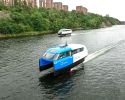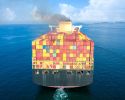Eight new incentives are proposed for shipping's climate transition

The EU is leading the way and the IMO will hopefully hang on. But what can Sweden do to speed up the transformation of shipping? Transport Analysis has identified eight incentives that can contribute to change.
Yesterday, the European Parliament adopted the bill on shipping's climate transition, FuelEU Maritime, which is part of the EU's large climate package "Fit for 55". The bill, which involves emission limits for ships calling at EU ports, will now be negotiated in trilogue between the European Parliament, the Council of Ministers and the European Commission before it is finally adopted. Negotiations are also ongoing regarding shipping's incorporation into the EU's emissions trading system, EU/ETS, which is expected to come into force from 2024.
Sharp policy instruments at supranational and international level are, of course, a prerequisite for shipping, which is an international business, to be able to adjust. But even at the national level, things can be done to speed up development. Transport Analysis, in its work to produce data for the upcoming climate policy action plan, has identified eight control instruments that could be possible to introduce.
When it comes to financial instruments, it is proposed, among other things, that more climate-controlling incentives be introduced into the Swedish Maritime Administration's fees - something that requires the Swedish Maritime Administration to receive additional funding in the form of permanent grants.
Sweden has criticized that the stricter requirements in Fit for 55 only apply to ships from 5,000 gross tons and up. Therefore Transport Analysis proposes that Sweden nationally introduces a policy whereby the greenhouse gas intensity in fuel also applies to smaller vessels, for example from 400 gross tons.
Transport Analysis also suggests that the state go ahead with the transition and set tough and more detailed requirements to adapt the government fleet to the climate. Today, the regulation governing this is too general, they say. Another proposal is that the Swedish Transport Administration be tasked with setting tougher requirements when procuring Gotland traffic, for example on fuel or changed traffic layouts that enable speed reductions and greatly reduced energy consumption.
Transport Analysis also proposes several "control measures to increase knowledge about climate control measures". Here, for example, a "conversion program according to the Norwegian model" is proposed. This program, to be established at the initiative of the state, is a "public private partnership and a forum for a broad gathering of shipping actors from both the seller and buyer side as well as from the relevant authorities and academia". The idea is to speed up and accelerate technology development "by having participants in the program initiate and jointly finance investments in pilot projects in early development phases", which according to Transport Analysis "reduces the financial risk for new transport solutions and for unproven technology".
Read about more control measures in the Transport Analysis memorandum (in swedish)
-
 NextWave – en podd som ska locka unga
NextWave – en podd som ska locka unga -
 Ny studie: Eldrivna pendelbåtar kan effektivisera Stockholms kollektivtrafik
Ny studie: Eldrivna pendelbåtar kan effektivisera Stockholms kollektivtrafik -
 Sjöfartens utsläpp ökar
Sjöfartens utsläpp ökar -
 Sociala relationer påverkar val av bränsle
Sociala relationer påverkar val av bränsle -
 Sjöfartens omställning kräver ”mjukare” påtryckningar
Sjöfartens omställning kräver ”mjukare” påtryckningar -
 Hon hade avtalad tid med Kapten ynkrygg
Hon hade avtalad tid med Kapten ynkrygg -
 Lighthouse omvärldsanalys 2025 – osäkerhet och tullar präglar sjöfarten
Lighthouse omvärldsanalys 2025 – osäkerhet och tullar präglar sjöfarten -
 Se seminariet Shipping in the Marine Environment
Se seminariet Shipping in the Marine Environment -
 Vad betyder egentligen de 90 procenten?
Vad betyder egentligen de 90 procenten? -
 Hålla där...
Hålla där...

